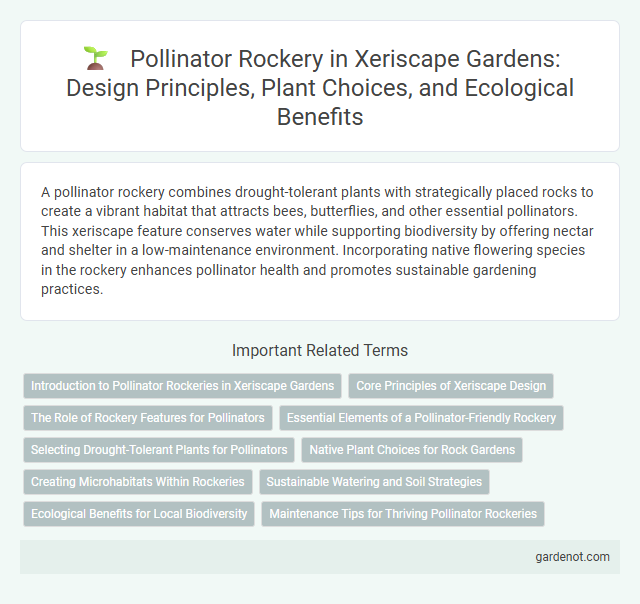A pollinator rockery combines drought-tolerant plants with strategically placed rocks to create a vibrant habitat that attracts bees, butterflies, and other essential pollinators. This xeriscape feature conserves water while supporting biodiversity by offering nectar and shelter in a low-maintenance environment. Incorporating native flowering species in the rockery enhances pollinator health and promotes sustainable gardening practices.
Introduction to Pollinator Rockeries in Xeriscape Gardens
Pollinator rockeries in xeriscape gardens create essential habitats for bees, butterflies, and other pollinators by combining drought-tolerant plants with strategically placed rocks that provide shelter and nesting sites. These rockeries utilize native, low-water plants like lavender, salvia, and yarrow to support pollinator populations while conserving water resources. Integrating pollinator rockeries enhances biodiversity and promotes sustainable gardening in arid landscapes.
Core Principles of Xeriscape Design
Pollinator rockeries embrace xeriscape design principles by prioritizing water-efficient plants native to arid environments, fostering biodiversity with nectar-rich blooms that attract bees, butterflies, and other pollinators. Strategic placement of drought-tolerant perennials and succulents maximizes water retention while minimizing irrigation needs, enhancing soil health through mulching and reduced disturbance. Integrating these elements creates a resilient, sustainable garden that supports local ecosystems and conserves water resources effectively.
The Role of Rockery Features for Pollinators
Rockery features in xeriscape gardens provide essential habitats and foraging opportunities for pollinators such as bees, butterflies, and hummingbirds. The varied textures and microclimates created by rocks support diverse pollinator species by offering shelter, nesting sites, and temperature regulation. Strategic placement of native flowering plants among rocks enhances nectar availability, boosting pollinator activity and promoting biodiversity.
Essential Elements of a Pollinator-Friendly Rockery
A pollinator rockery thrives with native, nectar-rich flowering plants and a variety of textures such as stones and wood to provide shelter and breeding sites. Incorporating water sources like shallow dishes or mini ponds is crucial for hydration and attracting diverse pollinators including bees, butterflies, and hummingbirds. Optimal sunlight exposure and minimal pesticide use enhance pollinator activity and ensure a sustainable ecosystem within the xeriscaped garden.
Selecting Drought-Tolerant Plants for Pollinators
Selecting drought-tolerant plants such as lavender, sedum, and blanket flower is essential for establishing a pollinator rockery that thrives in xeriscape gardens. These native, low-water-use species provide vital nectar and pollen sources for bees, butterflies, and hummingbirds while conserving water resources. Incorporating a variety of flowering plants with staggered bloom times enhances habitat diversity and sustains pollinator populations throughout the dry season.
Native Plant Choices for Rock Gardens
Native plant choices for pollinator rockeries include drought-tolerant species such as Echinacea purpurea, Sedum ternatum, and Asclepias tuberosa, which thrive in well-drained, rocky soils. These plants provide essential nectar and pollen sources for bees, butterflies, and hummingbirds while requiring minimal irrigation, aligning with xeriscape principles. Incorporating native grasses like Bouteloua gracilis further enhances habitat diversity and soil stability in rock garden settings.
Creating Microhabitats Within Rockeries
Pollinator rockeries enhance xeriscape gardens by creating microhabitats that support diverse pollinator species such as bees, butterflies, and hummingbirds. Utilizing varied rock sizes and native drought-tolerant plants provides shelter, nesting sites, and nectar sources critical for pollinator survival. Strategic placement of rocks and plants optimizes sunlight exposure and moisture retention, fostering a balanced ecosystem within arid landscapes.
Sustainable Watering and Soil Strategies
Pollinator rockeries optimize sustainable watering by incorporating drought-tolerant plants and using drip irrigation systems that minimize water waste. Soil strategies emphasize the use of well-draining, nutrient-rich substrates enhanced with organic mulch to retain moisture while supporting native pollinator habitats. Integrating permeable rock elements helps reduce runoff and promotes water infiltration, creating an eco-friendly xeriscape environment.
Ecological Benefits for Local Biodiversity
Pollinator rockeries enhance local biodiversity by providing essential habitats and food sources for native bees, butterflies, and other pollinators, which are crucial for ecosystem health. These rockeries support a variety of drought-tolerant flowering plants that bloom at different times, ensuring continuous nectar and pollen availability throughout the seasons. By fostering diverse pollinator populations, xeriscape pollinator rockeries contribute to improved plant reproduction, soil stability, and the resilience of local ecosystems.
Maintenance Tips for Thriving Pollinator Rockeries
To ensure a thriving pollinator rockery, prioritize planting native, drought-tolerant species that attract bees, butterflies, and other pollinators. Maintain soil health by incorporating organic mulch and monitoring moisture levels to prevent overwatering. Regularly remove invasive weeds and deadhead flowers to promote continuous blooming and support pollinator activity.
Pollinator rockery Infographic

 gardenot.com
gardenot.com